Revolutionize Your Business: The Ultimate Guide to Queue Management Systems for Enhanced Customer Experience
In today’s fast-paced business environment, customer experience is everything. Long queues can turn a positive interaction into a frustrating ordeal, leading to lost sales and diminished loyalty. Enter Queue Management Systems—an innovative solution designed to streamline customer flow and enhance satisfaction. This ultimate guide will take you through the transformative benefits of implementing a queue management system for your business. Whether you're running a retail store, a restaurant, or a service center, these systems can significantly reduce wait times, improve service efficiency, and ultimately create a more organized environment. Discover how technology can pave the way for happier customers and increased revenue, and learn about best practices to revolutionize your approach to customer management. Your journey towards a more efficient business begins here!
Revolutionize Your Business: The Ultimate Guide to Queue Management Systems for Enhanced Customer Experience
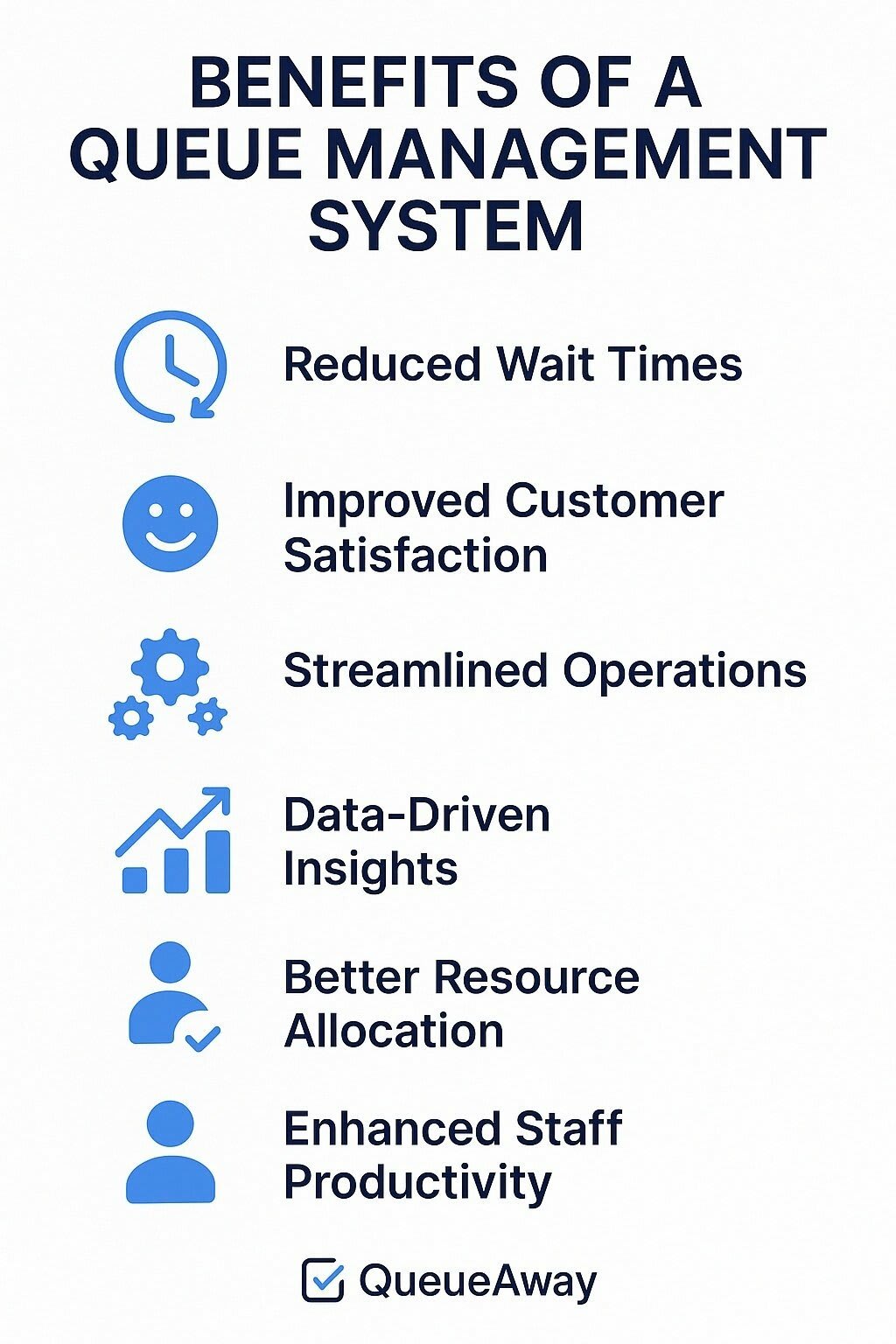
Top Benefits of a Queue Management System – Why Your Business Needs One
Reduced wait times, improved customer satisfaction, streamlined operations, data-driven insights, enhanced staff productivity. Perfect for businesses aiming to optimize service delivery, this is why a smart queue management system like QueueAway is essential for improving customer experiences and operational efficiency.
The Importance of Queue Management in Customer Experience
In the modern business landscape, customer experience has become a pivotal factor in determining the success and longevity of any enterprise. As businesses across various sectors strive to meet the ever-growing expectations of their clientele, one significant aspect that cannot be overlooked is queue management. Long waits and disorganized queues can quickly turn what would otherwise be a positive interaction into a frustrating experience, often resulting in lost sales and diminished customer loyalty.
Effective queue management is crucial because it directly impacts the perception customers have of your business. When customers face long waiting times or chaotic queue arrangements, their overall experience is negatively affected, leading to dissatisfaction. Conversely, a well-managed queue system can significantly enhance the customer journey, making it more streamlined and enjoyable. By reducing wait times and ensuring that customers are served promptly, businesses can foster a positive environment that encourages repeat visits and builds customer loyalty.
Moreover, queue management is not just about reducing wait times; it's about optimizing the entire service process. It involves understanding customer flow, predicting peak times, and efficiently allocating resources to meet demand. A robust queue management system can help businesses achieve these goals by providing real-time data and analytics, enabling informed decision-making. This proactive approach ensures that customers receive timely and efficient service, thereby enhancing their overall experience and satisfaction.
Businesses that invest in customer experience outperform their competitors… Forbes: 50 Stats Showing the Importance of Customer Experience
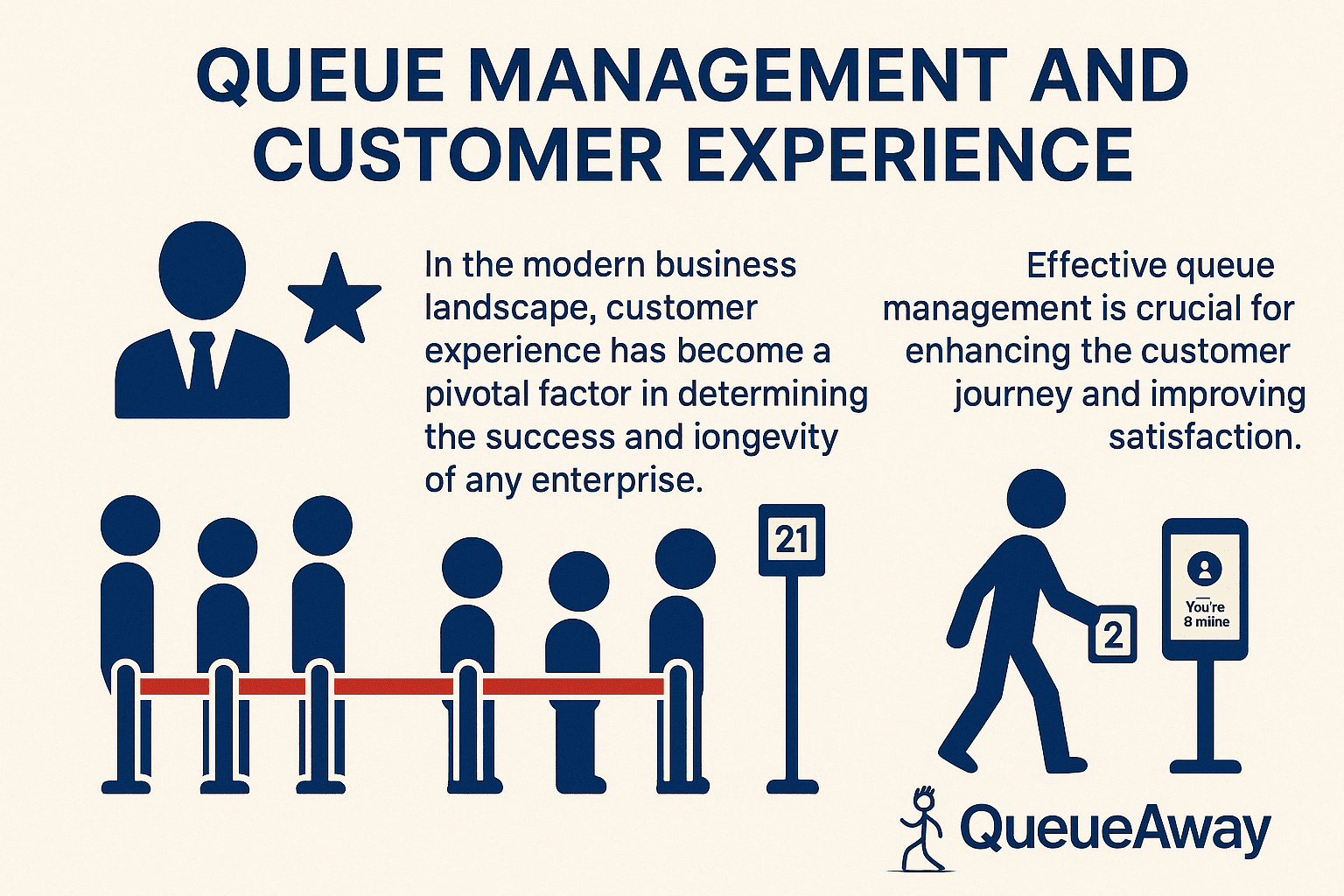
Queue Management systems and Customer Experience – A Strategic Advantage with QueueAway
Enhance customer experience by minimizing wait times and streamlining service, with QueueAway the smart solution for businesses
Key Features of Effective Queue Management Systems
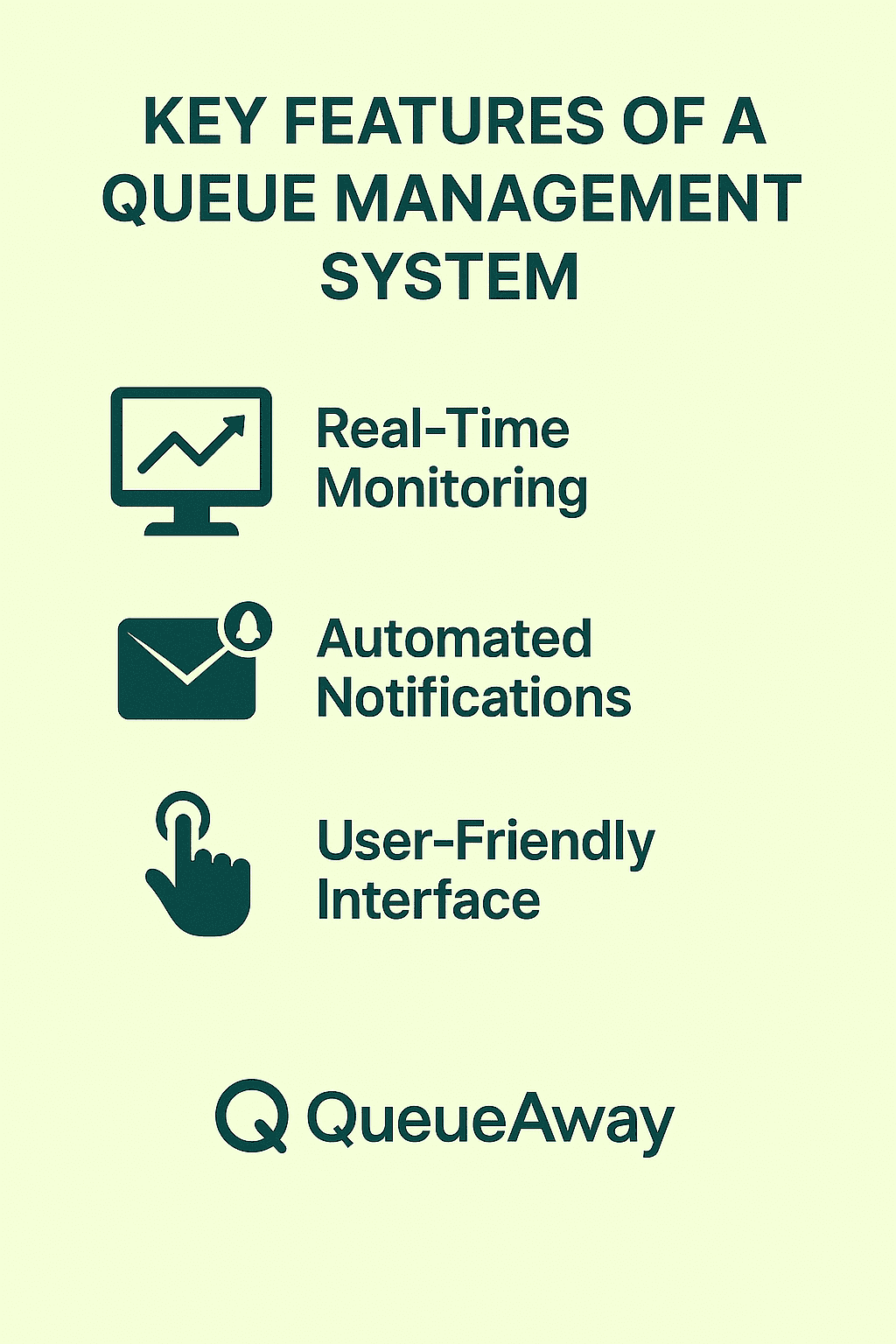
Key Features of a Queue Management System – Powered by QueueAway
This visual highlights essential features of a queue management system—real-time monitoring, automated notifications, and a user-friendly interface—all integral to QueueAway’s innovative solution.
For a queue management system to be truly effective, it must incorporate a range of key features designed to streamline operations and enhance customer experience. One of the most critical features is real-time monitoring and analytics. By providing businesses with up-to-the-minute data on customer flow, wait times, and service efficiency, this feature allows for quick adjustments and optimizations to meet evolving demands.
Another essential feature is automated customer notifications. Through SMS, email, or app notifications, customers can receive updates on their queue status, estimated wait times, and service alerts. This transparency keeps customers informed and reduces their frustration, as they are aware of what to expect. Additionally, it allows them to manage their time more effectively, knowing when they need to be present for their turn.
A user-friendly interface is also vital for both customers and staff. For customers, easy-to-use kiosks or mobile apps for check-ins and queue tracking enhance convenience and reduce confusion. For staff, intuitive dashboards and management tools facilitate efficient queue handling and resource allocation. Integration with existing systems, such as CRM and POS, further enhances operational efficiency by centralizing information and streamlining workflows.
Types of Queue Management Systems: Which One is Right for You?
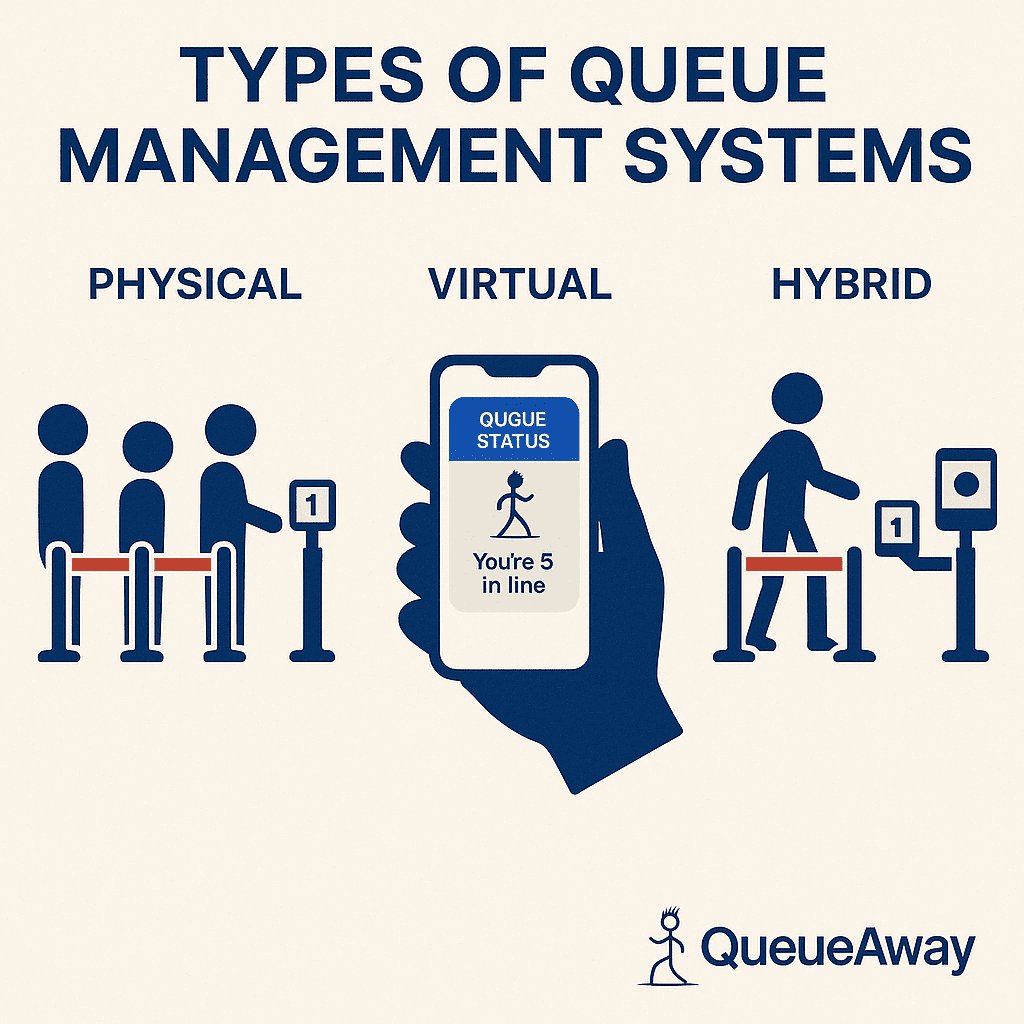
Queue Management Systems – Powered by QueueAway
QueueAway provides flexible, scalable solutions tailored to any business environment. Whether managing in-store foot traffic or remote check-ins, QueueAway enhances efficiency and customer experience across all queuing formats
Choosing the right queue management system for your business depends on various factors, including the nature of your operations, the volume of customer traffic, and specific business needs. There are several types of queue management systems available, each with its unique features and advantages.
Physical queue management systems involve the use of barriers, signage, and ticket dispensers to organize and manage customer flow. These systems are ideal for businesses with high foot traffic, such as banks, retail stores, and public service centers. They provide a clear and tangible way for customers to understand their position in the queue and how long they need to wait.
Virtual queue management systems leverage technology to allow customers to join a queue remotely, often via mobile apps or online platforms. This type of system is particularly beneficial for businesses like restaurants and healthcare facilities, where customers may prefer to wait off-site. Virtual queues can significantly enhance convenience and reduce overcrowding, as customers can continue with other activities while waiting for their turn.
Hybrid queue management systems combine both physical and virtual elements to provide a comprehensive solution. These systems are versatile and can be tailored to meet the specific needs of different businesses. For example, a retail store might use physical tickets for in-store customers while offering a virtual queue option for those who prefer to wait outside the premises. This flexibility ensures that all customers have a positive experience regardless of their preferences.
Benefits of Implementing a Queue Management System
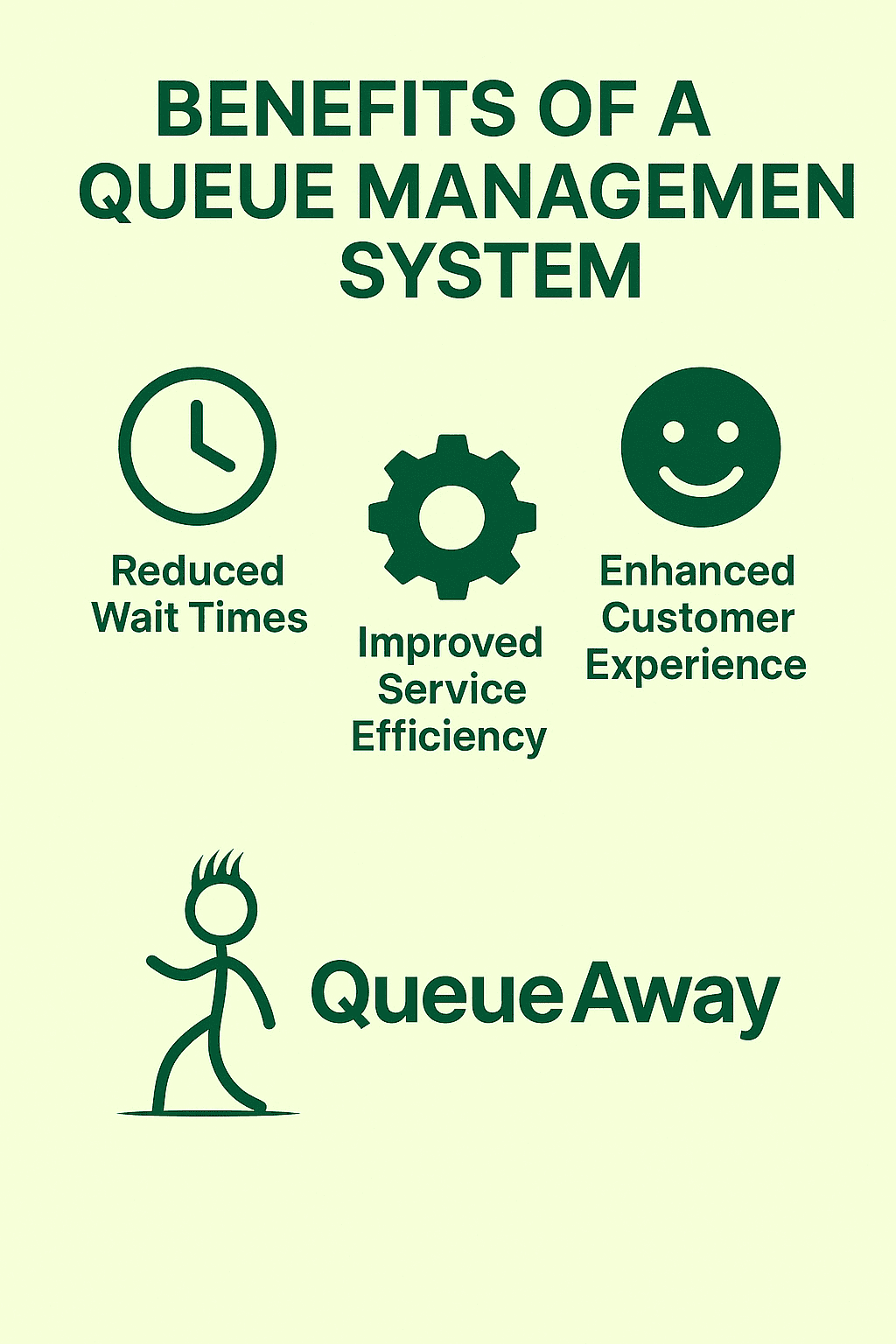
Top Business Benefits of Implementing a Queue Management System – QueueAway
Highlights the key benefits of a queue management system—reduced wait times, improved service efficiency, and enhanced customer experience—all made possible with QueueAway’s smart queuing solutions.
Implementing a queue management system offers a plethora of benefits that can transform the way your business operates and interacts with customers. One of the most immediate advantages is the reduction in wait times. By efficiently managing customer flow and service processes, these systems can significantly decrease the time customers spend waiting, leading to higher satisfaction levels.
Improved service efficiency is another significant benefit. Queue management systems enable businesses to optimize resource allocation and staff productivity. With real-time data on customer volumes and service times, managers can make informed decisions about staffing levels and service points, ensuring that resources are used effectively. This leads to faster service delivery and a more organized environment.
Enhanced customer experience is perhaps the most valuable benefit of implementing a queue management system. When customers experience shorter wait times and efficient service, their overall perception of the business improves. Happy customers are more likely to return and recommend the business to others, driving loyalty and growth. Additionally, the transparency and convenience offered by queue management systems, such as real-time notifications and virtual queuing options, further enhance the customer journey.
How to Choose the Right Queue Management System for Your Business
Selecting the right queue management system for your business involves careful consideration of various factors to ensure that the chosen solution aligns with your operational needs and customer expectations. The first step is to assess the specific requirements of your business. Consider the volume of customer traffic, peak times, and the nature of your services. Understanding these aspects will help you identify the features and capabilities needed in a queue management system.
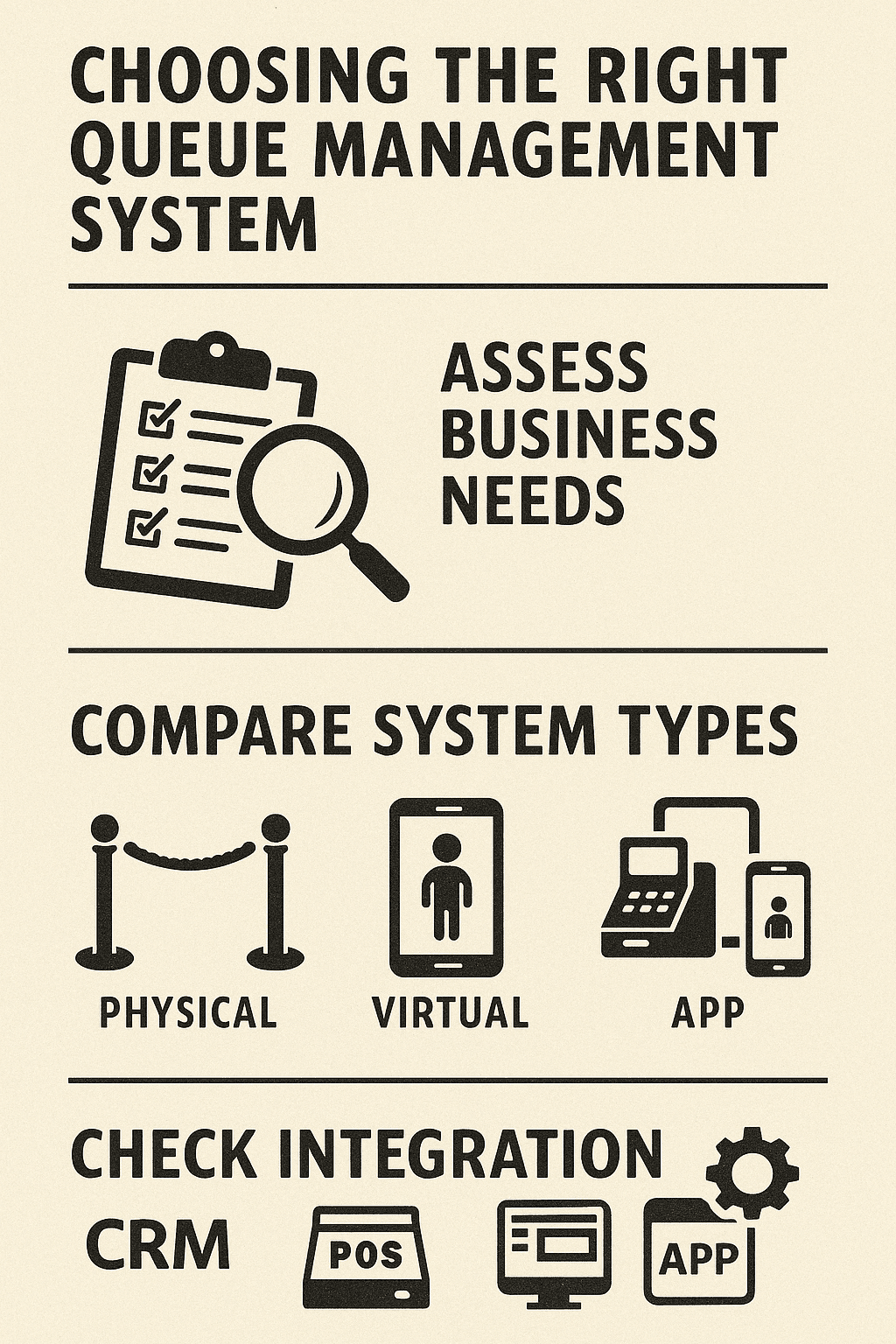
How to Choose the Right Queue Management System for Your Business
This vintage-style infographic breaks down how to select the best queue management system by assessing business needs, comparing system types, and ensuring integration compatibility with tools like CRM and POS.
Next, evaluate the different types of queue management systems available. Physical systems are suitable for businesses with high foot traffic and straightforward service processes, while virtual systems offer convenience for customers who prefer remote waiting. Hybrid systems provide the flexibility to cater to diverse customer preferences. Consider which type aligns best with your business model and customer behavior.
Integration capabilities are also crucial when choosing a queue management system. Ensure that the system can seamlessly integrate with your existing technologies, such as CRM, POS, and other management tools. This integration will streamline operations and provide a unified view of customer data, enhancing overall efficiency. Additionally, look for systems that offer customizable features to tailor the solution to your specific needs.
Integrating Queue Management Systems with Other Technologies
Integrating queue management systems with other technologies can significantly enhance the overall efficiency and effectiveness of your business operations. One of the most beneficial integrations is with Customer Relationship Management (CRM) systems. By linking queue management with CRM, businesses can access valuable customer data, such as previous interactions and preferences, enabling personalized service and improved customer satisfaction.
Another important integration is with Point of Sale (POS) systems. Connecting queue management with POS allows for streamlined transactions and better resource allocation. For example, if a queue management system detects a high volume of customers, it can prompt the POS system to open additional service points or allocate more staff to handle the demand. This coordination ensures that customers receive timely service and reduces bottlenecks in the queue.
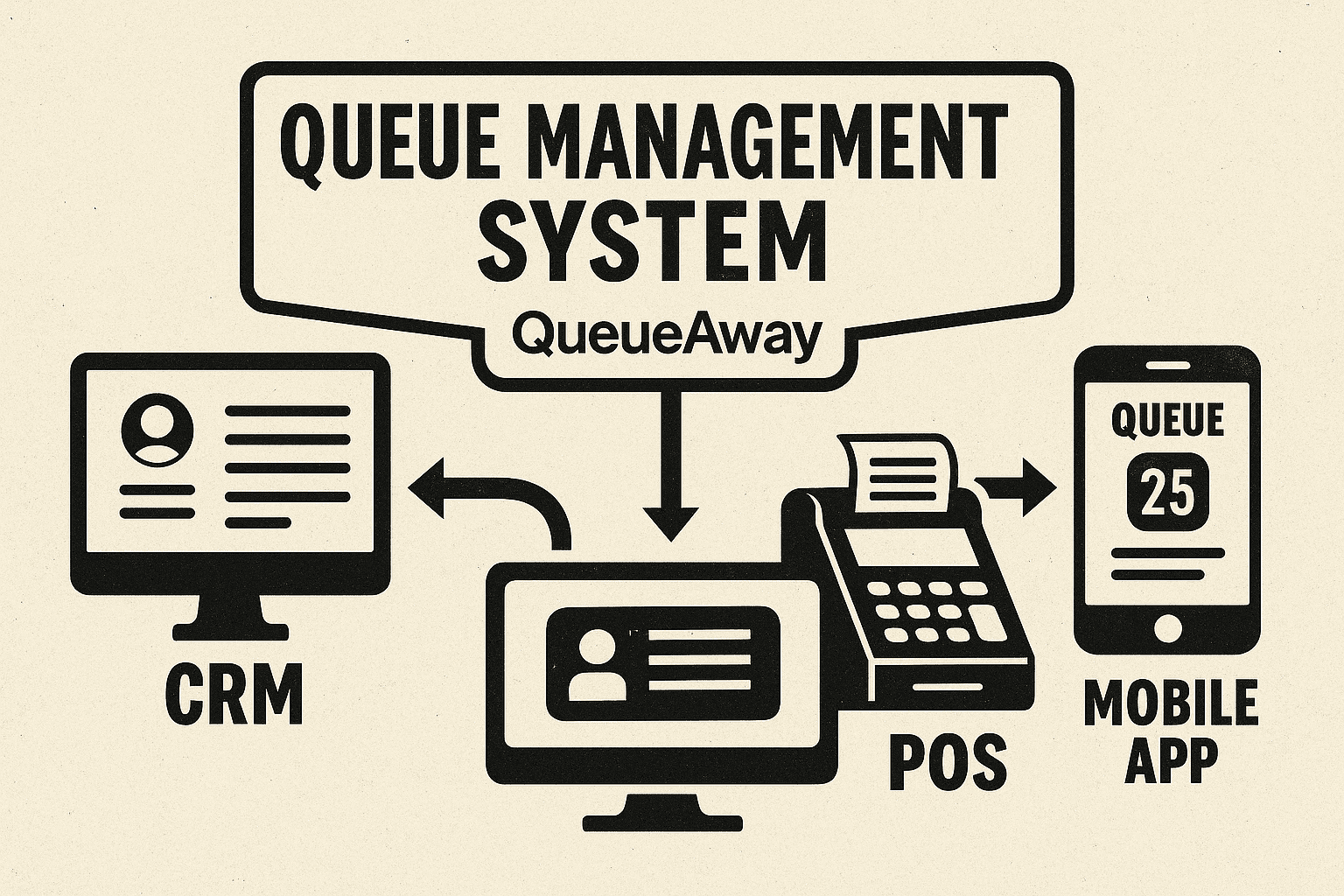
Technology Integration with Queue Management Systems – Powered by QueueAway
QueueAway’s queue management system mobile apps to improve service delivery, customer experience, operational efficiency.
Integrating queue management systems with mobile apps and online platforms also enhances customer convenience. Customers can use these tools to check-in, monitor their queue status, and receive notifications. This integration not only reduces physical crowding but also provides a seamless and efficient customer experience. Additionally, businesses can leverage analytics from these integrations to gain insights into customer behavior and optimize service processes accordingly.
Real-World Case Studies: Success Stories of Queue Management Implementation
Real-world case studies provide valuable insights into the successful implementation of queue management systems and their transformative impact on businesses. One notable example is a major retail chain that implemented a hybrid queue management system to manage high customer traffic during peak shopping seasons. By combining physical ticket dispensers with a mobile app for virtual queuing, the chain significantly reduced wait times and improved customer satisfaction. The system also provided real-time analytics, helping the chain optimize staffing and service points.
Another success story comes from a healthcare facility that adopted a virtual queue management system to streamline patient flow. Patients could join the queue remotely via an app, receive notifications on their status, and arrive at the facility when their turn was approaching. This system reduced overcrowding in waiting areas and enhanced the overall patient experience. The facility also saw a decrease in appointment no-shows and improved operational efficiency.
A popular restaurant chain implemented a queue management system to handle the high volume of diners during peak hours. By using a combination of physical kiosks and a mobile app, the restaurant allowed customers to join the queue from anywhere and receive notifications on their table status. This system not only reduced waiting times but also improved customer satisfaction by providing transparency and convenience. The restaurant experienced increased repeat visits and positive reviews as a result.
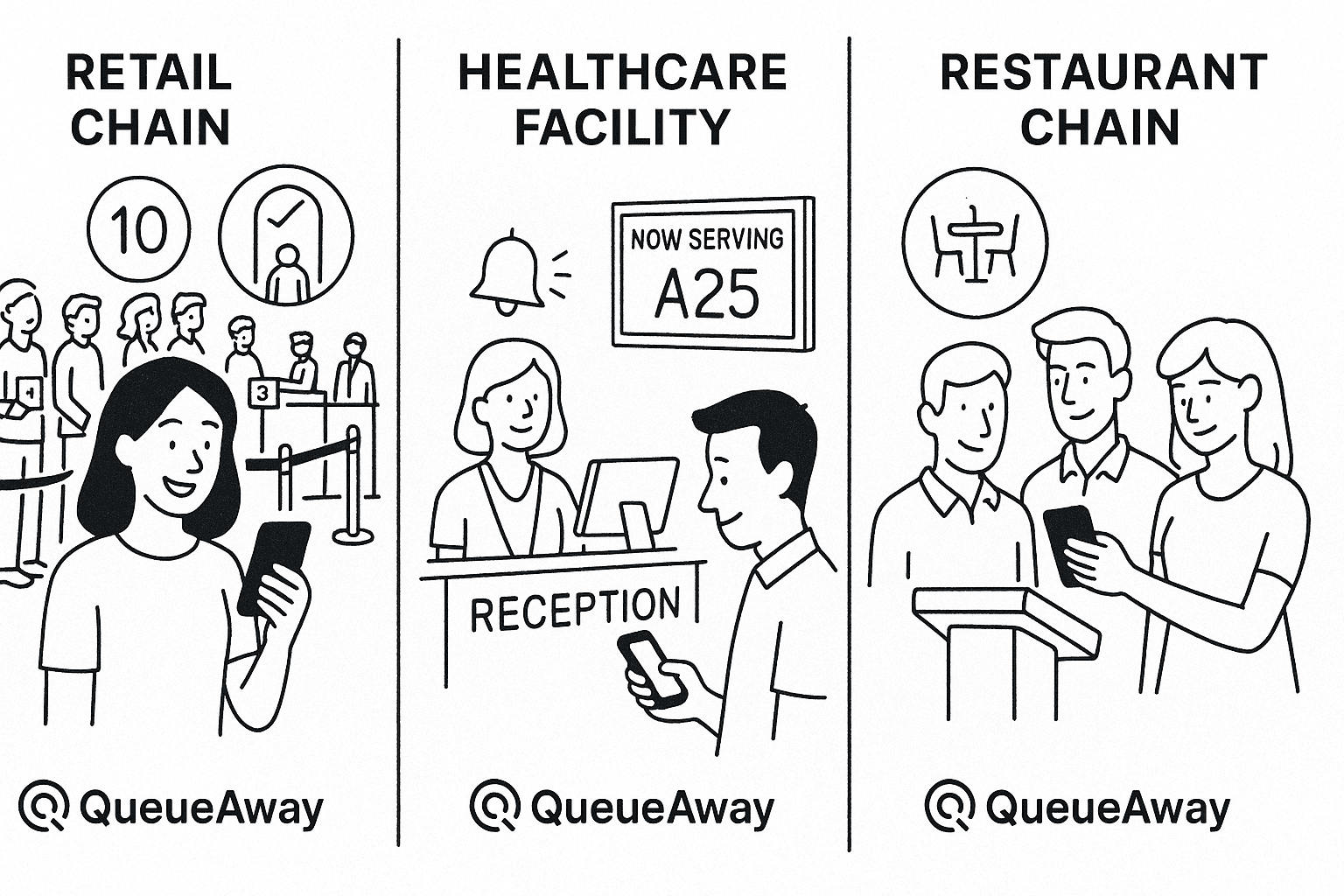
Real-World Case Studies of Queue Management Systems – QueueAway in Action
Real-world success stories of QueueAway in barbershops, healthcare check-ins, and restaurants, highlighting how queue management systems improve customer flow and service quality.
Common Challenges and Solutions in Queue Management
While queue management systems offer numerous benefits, businesses may encounter certain challenges during implementation and operation. One common challenge is resistance from staff and customers who are accustomed to traditional queuing methods. To address this, businesses should provide comprehensive training and demonstrations to ensure that everyone understands the advantages and functionalities of the system.
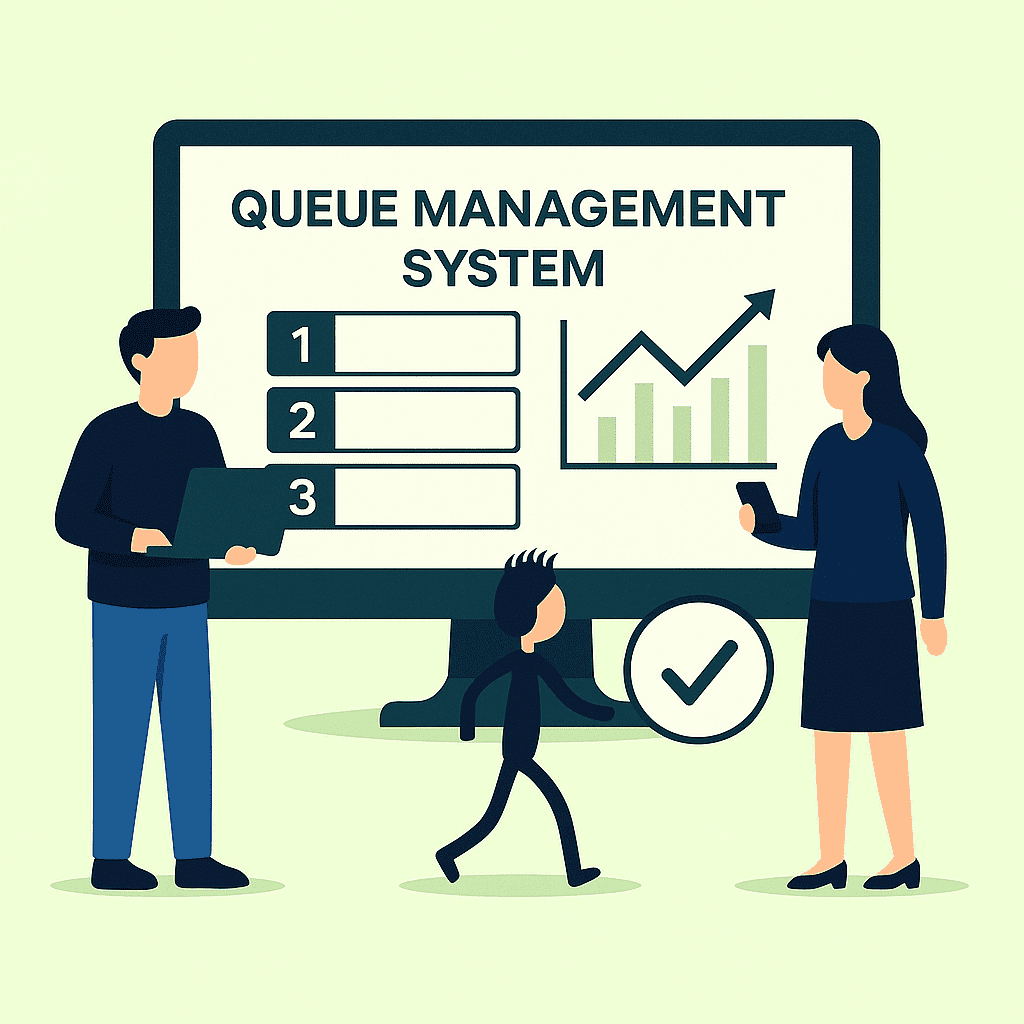
Overcoming Challenges in Queue Management System Implementation
This visual illustrates common challenges faced during queue management system implementation, such as user adaptation, system integration, and handling peak demand—key areas addressed by QueueAway’s robust and flexible solutions
Another challenge is the integration of queue management systems with existing technologies. Businesses may face difficulties in connecting the new system with their CRM, POS, and other tools. To overcome this, it is essential to choose a queue management solution with robust integration capabilities and seek support from the provider for smooth implementation. Additionally, conducting thorough testing before full deployment can help identify and resolve integration issues.
Managing peak times and high customer volumes can also pose challenges. Queue management systems must be capable of handling sudden surges in demand and ensuring efficient service delivery. Businesses can address this by leveraging real-time analytics and predictive tools offered by the system to anticipate peak times and allocate resources accordingly. Regular monitoring and adjustments based on data insights can help maintain optimal performance even during busy periods.
Poor service leads to billions in lost revenue each year… NewVoiceMedia Report via Forbes
Future Trends in Queue Management Systems and Customer Experience
The future of queue management systems is poised to be shaped by advancements in technology and evolving customer expectations. One of the emerging trends is the increased use of artificial intelligence (AI) and machine learning. These technologies can enhance predictive analytics, enabling businesses to forecast customer flow and optimize resource allocation more accurately. AI can also facilitate chatbot integrations for automated customer interactions, further streamlining the queue management process.
Another trend is the growing importance of mobile and online platforms for queue management. As customers continue to seek convenience and flexibility, businesses will increasingly adopt virtual queuing solutions that allow customers to join queues remotely and receive real-time updates. Mobile apps and online portals will become integral to queue management strategies, providing seamless and efficient customer experiences.
Personalization and customization will also play a significant role in the future of queue management systems. Businesses will leverage customer data to offer tailored experiences, such as personalized notifications and service preferences. Customizable features within queue management systems will allow businesses to adapt the solution to their specific needs, ensuring that customers receive a unique and satisfying experience.
Hello, World!
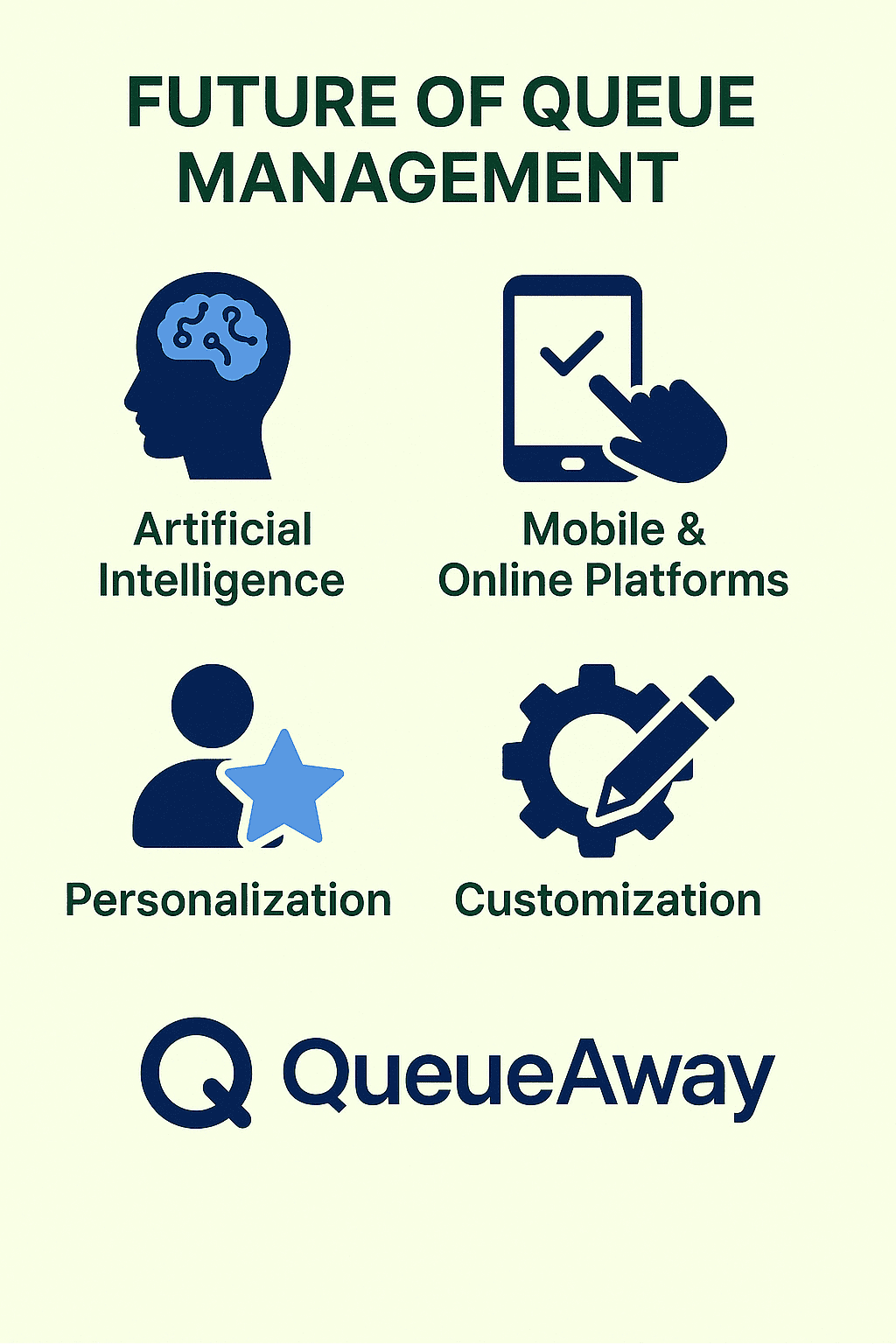
Future Trends in Queue Management Systems – Powered by QueueAway
Future trends in queue management, highlighting AI, mobile platforms, personalization, and customization—core innovations offered by QueueAway to improve customer experience and service efficiency.
In conclusion, queue management systems are a transformative tool that can revolutionize your business by enhancing customer experience, improving service efficiency, and creating a more organized environment. By understanding the importance of queue management, exploring key features, selecting the right system, integrating with other technologies, learning from real-world case studies, addressing common challenges, and staying abreast of future trends, businesses can pave the way for happier customers and increased revenue. Your journey towards a more efficient and customer-centric business starts here!
Transform Your Customer Experience with QueueAway
Long queues and extended wait times can deter potential customers and impact your business's reputation. QueueAway offers an innovative virtual queue management system that allows your clients to join queues remotely, receive real-time updates, and arrive just in time for their service. This not only enhances customer satisfaction but also optimizes your operational efficiency.waitwhile.com+11Android Apps on Google Play+11QueueAway+11QueueAway+1QueueAway+1
Join the ranks of successful businesses that have streamlined their operations and improved customer experiences with QueueAway. With flexible pricing starting at just $19.99 / £14.99 per month and no hidden fees, it's an affordable solution for businesses of all sizes.
👉 Discover how QueueAway can revolutionize your business today
Frequently Asked Questions (FAQs)
Q1: What is queue management system software?
Queue management system software is a digital solution designed to streamline and organize the customer journey by managing wait lines—virtual or physical—in a structured and efficient manner. These systems help businesses minimize customer wait times, maximize staff efficiency, and improve the overall service experience.
Q2: Why is queue management important for businesses in 2025?
Effective queue management is crucial because long wait times remain one of the most common complaints across industries. Studies show that businesses equipped with digital queue management solutions consistently outperform their competitors. For instance, poor customer service—often caused by unmanaged queues—costs U.S. businesses an estimated $75 billion annually.
Q3: What are the key features of modern queue management systems?
Modern queue management systems offer features such as:
Virtual check-ins through mobile or web apps
SMS and app-based notifications for queue status
Dynamic wait time estimates
Analytics dashboards for queue performance
Integration with CRM and other business tools
Q4: How do virtual queue systems enhance customer experience?
Virtual queue systems allow customers to join queues remotely via mobile apps, web links, or kiosks. This flexibility reduces physical crowding, provides real-time updates, and allows customers to wait comfortably from any location, thereby enhancing the overall customer experience.
Q5: What industries benefit most from queue management systems?
Industries such as healthcare, retail, banking, education, and government services benefit significantly from queue management systems. These sectors often deal with high customer volumes and can leverage queue management software to improve service efficiency and customer satisfaction.


